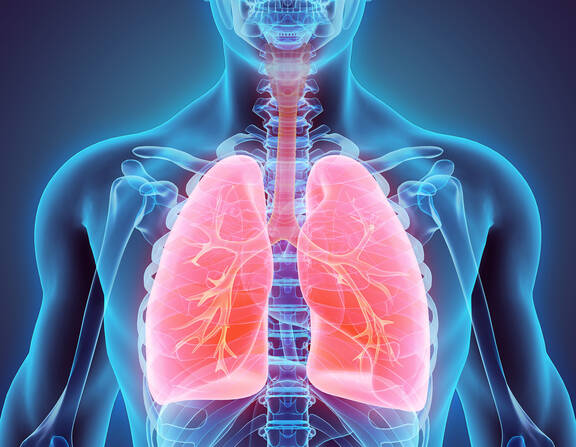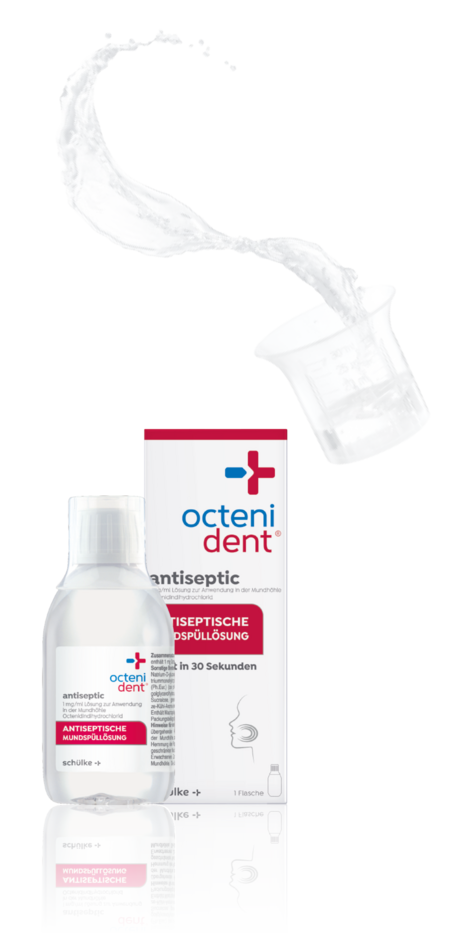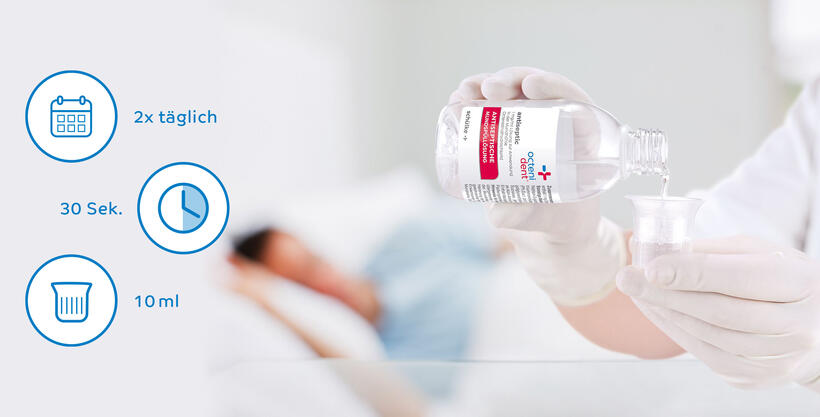
Pneumonia prophylaxis
Pneumonia is a major challenge in the area of nosocomial infections. In order to reduce their incidence in hospitals, effective infection prevention strategies must be adhered to. Find out more about pneumonia prevention measures and how targeted oral hygiene can help in the following article.
Go directly to the desired content:
Relieving the burden on healthcare systems: Avoiding nosocomial infections
Hospital-acquired infections, i.e. nosocomial infections, are among the most common complications of medical treatment.1 This not only poses a risk to patients, but also places a considerable burden on the healthcare system: around 8.9 million people across Europe contract nosocomial infections every year.2 In Germany, the figure is 400,000 to 600,000 patients with up to 20,000 deaths.3 Yet up to half of all nosocomial infections could be avoided through better hygiene measures.4,5,6 The World Health Organization (WHO) estimates the annual costs for Europe at around seven billion euros.7
In addition to avoidable deaths, nosocomial infections exacerbate the development of resistance to antibiotics and sometimes have long-term consequences, including disability or incapacity to work.1 Post-operative wound infections, urinary tract infections and pneumonia, for example, pose major challenges.8
Definition of pneumonia
Pneumonia (lung inflammation) is an inflammation of the alveoli and/or interstitial lung tissue.9,10 It can be acute or chronic.9 Among other things, it can occur when people are unable to brush their teeth and bacteria increasingly colonize their teeth, gums and oral cavity. These sometimes enter the respiratory tract through microaspiration, where they can in turn trigger pneumonia. The spectrum of pathogens depends on the age group and cause of infection - bacteria are the most common triggers, but viruses or fungi are less common11.
Pneumonia is one of the most common nosocomial infections
Ventilator-associated pneumonia (VAP) is one of the most common hospital-acquired infections.12 A pneumonia is considered ventilator-associated if it occurs at least 48 hours after endotracheal intubation.13 Patients in intensive care units have an increased risk of VAP because their oral flora changes to primarily Gram-negative organisms.14 Gram-negative bacteria are usually the trigger for pneumonia.8
VAP prophylaxis
Why suitable VAP prophylaxis is of great importance:
- 9 to 25 percent of intensive care patients are affected15
- Prolongation of hospital stay by around 6 to 9 days16, 17
- Additional costs of up to €30,000 per patient18,19,20,21,22
- Mortality: 9 to 13 percent23
Common causes of ventilator-associated pneumonia
Endotracheal intubation is considered the main risk factor for VAP.24 The risk of VAP is 21 times higher in intubated patients than in non-intubated patients.25 Common causes of ventilator-associated infections are:
- Colonization of the dental plaque with germs
- Bacterial infestation of the oropharyngeal area (mouth/throat)
- Inhalation of contaminated secretions from the oropharyngeal area
During intubation, the defense mechanisms of the airways are disrupted and expectoration and mucociliary clearance are impeded.24 Microaspiration of bacterial secretions that collect above the inflated blockage of the tube is facilitated and enables the formation of bacterial biofilms.24
Measures to prevent ventilator-associated pneumonia (VAP)
If the incidence of pneumonia is to be reduced, adherence to effective infection prevention strategies is essential. Antiseptic oral care is an important component of this, because without it, unwanted microorganisms continue to spread.13 Measures that prevent microaspirations are therefore suitable for VAP prophylaxis. In its guideline "Prevention of nosocomial ventilator-associated pneumonia", the KRINKO recommends a bundle of four different measures that should be observed:13
- basic (basic measures): Essential infection prevention is achieved through hand hygiene, sufficient staff, staff training, surveillance and wearing work clothes in intensive care units.
technical-apparatus: This includes changing ventilation tubes no more frequently than every seven days and active and passive respiratory gas humidification. - Pharmacological: In this area, selective bowel decontamination (SDD) or selective oral decontamination (SOD), for example, can contribute to infection prevention.
- patient-related: This includes positioning measures, enteral nutrition and hygienic oral care.

Oral care is an important component of patient-related measures. The KRINKO recommends regular oral care with antiseptic substances with proven efficacy to prevent ventilator-associated pneumonia.13 These include antiseptic mouthwash solutions such as octenident® antiseptic.
octenident® antiseptic: support for pneumonia prophylaxis
The oral antiseptic octenident® antiseptic reaches areas of the teeth, gums and tongue that are difficult to access. This makes it an effective alternative when when mechanical tooth cleaning is not possible or possible. The antiseptic mouth rinse is used to
- temporarily reduce the number of germs in the oral cavity
- temporary inhibition of plaque formation
and can therefore contribute to VAP prophylaxis, as described in the KRINKO guideline "Prevention of nosocomial ventilator-associated pneumonia".
The efficacy of o ctenident® antiseptic was proven in two clinical phase III studies in 201 patients compared to a placebo mouth rinse.26 The antimicrobial effect of octenident antiseptic is due to the broad spectrum of activity of octenidine, which covers Gram-negative and Gram-positive bacteria equally and can therefore also contribute to the decontamination of multi-resistant germs in the oral cavity. In addition to bactericidal efficacy, the spectrum of efficacy of the approved drug octenident® antiseptic also includes efficacy against yeasts (levurocide).*
octenident® antiseptic offers an effective, temporary alternative to tooth brushing and can make an effective contribution to pneumonia prophylaxis:
- Effective protection in just 30 seconds
- alcohol-free
- can also be used during pregnancy**
- with mint flavor for improved patient compliance
- low irritation and allergic potential

* The effect is rapid: Bactericidal after 30 seconds and levurocidal after 60 seconds (levurocidal efficacy proven in vitro).
** Observe the technical information.
Instructions for use

Patients: use octenident® antiseptic twice a day - preferably after meals. If this antiseptic is used immediately after brushing the teeth, the mouth must be rinsed thoroughly with water before using octenident® antiseptic. Pour 10 ml of the antiseptic mouthwash into the measuring cup provided and rinse the mouth thoroughly for about 30 seconds. Then spit out the solution. This should not be swallowed. Do not rinse the mouth with water immediately afterwards. Do not use this medicine for more than five consecutive days.
Oral hygiene in nursing care
Patients with limited oral care need special mouth rinses, such as octenident® antiseptic, to prevent infections.
Find out more about antiseptic mouth rinses in care settings here.
octenident® antiseptic
Fast action, easy to use, effective protection. Help prevent pneumonia in your patients with the octenident® antiseptic mouthwash solution.
About octenident® antiseptic
octenident® antiseptic 1 mg/ml oromucosal solution - Active substance: octenidine dihydrochloride. Composition: 1 ml of solution contains 1 mg of octenidine dihydrochloride. Other ingredients: glycerol 85 per cent (E 422), sodium gluconate, citric acid, disodium phosphate dihydrate (for pH adjustment), macrogolglycerol hydroxystearate, sucralose, purified water, mint flavour (contains propylene glycol (E 1520)). Indications: octenident antiseptic has an antimicrobial effect. It is used for temporary reduction of bacterial count in the oral cavity, for temporary inhibition of plaque formation, and in cases of insufficient oral hygiene capacity (no toothbrushing possible, for example) in adults. Contraindications: Allergy to octenidine dihydrochloride or any of the other ingredients. Undesirable effects: Very common: Temporary taste disturbance, such as bitter aftertaste; Mild, reversible dental discoloration. Common: Numb sensation in the mouth, Coating of the mouth or the tongue, Temporary tongue discoloration, Sensitivity of teeth. Uncommon: Headache, Nausea, Tingling of the tongue, More saliva in the mouth than normal.Revision 09/21
If any of the side effects get serious, or if you notice any side effects not listed in this user information, please tell your doctor or pharmacist.
Schülke & Mayr GmbH, 22840 Norderstedt, Germany, Tel. +49 40 52100-666, info@schuelke.com
1Mielke, M. "The Problem of Nosocomial Infections and Antibiotic Resistance from a Central European Perspective". Robert Koch Institute, 2008.
2 Geissel, Wolfgang. "Almost nine million nosocomial infections annually". Springer Medizin Verlag GmbH, Ärzte Zeitung, November 15, 2018, https://www.aerztezeitung.de/Medizin/Fast-neun-Millionen-nosokomiale-Infektionen-jaehrlich-227638.html.
3 "RKI - 2019 - Neue Schätzung zur Krankheitslast durch Krankenhaus-Infektionen". Rki.de, https://www.rki.de/DE/Content/Service/Presse/Pressemitteilungen/2019/14_2019.html. Accessed July 20, 2022.
4 European Centre for Disease Prevention and Control (ECDC), 2014: Healthcare-Associated Infections: https://ecdc. europa.eu/en/about-us/who-we-are/disease-programmes/ antimicrobial-resistance-and-healthcare-associated (last accessed 11.09.2018)
5 Uckay I. et al, 2013: Prevention of surgical site infections in orthopaedic surgery and bone trauma: state-of-the-art update.
6 Martiny H., Popp W., 2014: Krankenhausinfektionen (Public Health Forum 22 2014)
7 World Health Organization (WHO). "Guidelines on Core Components of Infection Prevention and Control Programs at the National and Acute Health Care Facility Level". 2016.
8 Aghdassi, S. J. S., et al. "German National Point Prevalence Survey on Nosocomial
Infections and Antibiotic Use". 2017.
9 "Pneumonia". Anvil.com, https://www.amboss.com/de/wissen/Pneumonie/. Accessed July 13, 2022.
10 "Pneumonia". gesundheitsinformation.de, https://www.gesundheitsinformation.de/lungenentzuendung.html. Accessed July 18, 2022.
11 "What is pneumonia?" Lungenaerzte-im-netz.de, https://www.lungenaerzte-im-netz.de/krankheiten/lungenentzuendung/was-ist-eine-lungenentzuendung/. Accessed July 18, 2022.
12 Rello, Jordi; Kollef, Martin H.; Diaz, Emili; Rodriguez, Alejandro (2010): Critical Care Infectious Diseases. Dordrecht: Springer
13 "Prävention der nosokomialen ventilator-associated pneumonia: Empfehlung der Kommission für Krankenhaushygiene und Infektionsprävention (KRINKO) beim Robert Koch-Institut". Bundesgesundheitsblatt, Gesundheitsforschung, Gesundheitsschutz, Vol. 56, No. 11, 2013, pp. 1578-1590, doi:10.1007/s00103-013-1846-7.
14 Munro CL, Grap MJ. Oral health and care in the intensive care unit: state of the science. Am J Crit Care 2004 Jan;13(1):25-33.
15 Fröhlich, M., et al. "Prevention of ventilator-associated pneumonia (VAP) in the intensive care unit - project to implement an evidence-based VAP bundle in the anesthesia and intensive care unit. 2013.
16. Beyersmann J, Gastmeier P, Grundmann H et al (2006) Use of multistate modelsto assess prolongation of intensive care unitstay due to nosocomial infection. Infect Control Hosp Epidemiol 27:493-499
17. Eber MR, Laxminarayan R, Perencevich EN, Malani A (2010) Clinical and economic outcomes attributable to health care-associated sepsis and pneumonia. Arch Intern Med 170:347-353.
18 Hunter JD: Ventilator associated pneumonia. BMJ 2012, 344: e3325. 10.1136/bmj.e3325
19. C.A. VAN NIEUWENHOVEN, E. BUSKENS, D.C. BERGMANS, F.H. VAN THIEL, G. RAMSAY et J.M. BONTEN, Oral decontamination is cost-saving in the prevention of ventilator associated pneumonia in intensive care units, 2004.
20. R.F. ABIDIA, Oral Care in the Intensive Care Unit : A Review, The Journal of Contemporary Dental Practice, Volume 8, No. 1, January 2007
21. R. GARCIA, A review of the possible role of oral and dental colonization on the occurrence of health care-associated pneumonia: Underappreciated risk and a call for interventions, AJIC, November 2005.
22. R. GARCIA, L. JENDRESKY, L. COLBERT, A. BAILEY, M. ZAMAN et M. MAJUMDER, Reducing Ventilator-Associated Pneumonia Through Advanced Oral-Dental Care: A 48-Month Study, AJCC, July 2009.
23 Melsen WG, Rovers MM, Groenwold RH et al (2013) Attributable mortality of ventilator-associated pneumonia: a meta-analysis of individual patient data from randomized prevention studies. Lancet Infect Dis 13:665-671
24 Sethi, S. "Ventilator-associated pneumonia". M. S. D. Manuals, 2019.
25 Rathgeber, J. "Grundlagen der maschinellen Beatmung". Klaus Züchner, Aktiv Druck & Verlag, 1999.
26 Jockel-schneider, Y., Schlagenhauf, U., Petsos, H., Rüttermann, S., Schmidt, J., Ziebolz, D., Wehner, C., Laky, M., Rott, T., Noack, M., Noack, B., & Lorenz, K. (2021). Impact of 0 . 1 % octenidine mouthwash on plaque re-growth in healthy adults : a multi-center phase 3 randomized clinical trial.
Data protection notice
We use analysis methods (e.g. cookies) to measure how often our website is visited and how it is used. We also use cookies to link your page visits and website usage with your customer data stored in our CRM system in order to be able to address you individually, i.e. based on your interests and usage. We alsowe embed third-party content from other providers (e.g. videos). We have no influence on further data processing and any tracking by the third-party provider.In this context, we also use service providers in third countries outside the EU that may not guarantee an adequate level of data protection, which entails the following risks Access by authorities without informing the data subject, no data subject rights, no legal remedies, loss of control.By hiring us, you consent to the processes described above. You can revoke your consent with effect for the future. You can find more information in our privacy policy

















